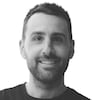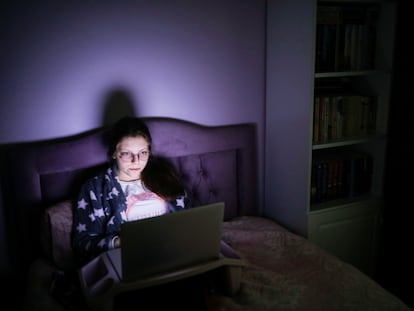Light pollution is a risk factor for various illnesses: ‘We’re facing a global threat’
Exposure to exterior nighttime illumination affects our biological clock and sleep quality, and a recent study links it to an elevated chance of having a stroke

In the mammoth illustrated book Stardust, in which Swedish author Hannah Arnesen reflects on the impact of being a human being on planet Earth, there are a few pages that collect fragments from the responses of a group of teenage students to the question, “What do you miss in life due to climate change?” Among the responses, there are two that point to the same problem. “Darkness,” one says. “Being able to see that sky. Where I live, there is light pollution,” goes another.
That was no coincidence. According to numbers from the report The new world atlas of artificial night sky brightness, published by Science magazine in 2016, more than 80% of the global population and nearly 100% of the U.S. and Europe live underneath skies that are contaminated by light. This has led to the disappearance of the Milky Way for six out of every 10 Europeans. On 88% of European land surface, residents experience nights with light pollution.
“Light pollution is a growing environmental problem. Every year, the illuminated portion of the Earth’s surface and the intensity of artificial light in the night sky grows by 2.2%. We are facing a worldwide threat that is growing very rapidly,” reflects Alicia Pelegrina, researcher at the Astrophysics Institute of Andalusia (IAA). In 2021, the Spanish National Research Council, through the IAA’s Sky Quality Office, participated in a study that showed that light pollution had increased by about 50% over the last 25 years.
Pelegrina, author of an essay entitled La contaminación lumínica (Light pollution), believes that the threat is not seen as such by those it impacts, and that we continue to associate artificial nighttime light with progress, wealth, security, beauty, entertainment, and wellness. “But let’s not fool ourselves, even if light pollution is not something you can touch, nor does it smell or make noise, it is contamination in the strictest sense of the word and constitutes a threat, and not just for astronomical observatories or for the balance of ecosystems. Although our understanding of the effects of light pollution on our health is still developing, it seems clear that our health is also at risk,” says the expert.
One new entry into the still-nascent body of research on the effects of light pollution on our health is a study that was recently published in Stroke, an American Heart Association journal, which for the first time links elevated exposure to artificial, bright and exterior nocturnal light (such as fluorescent, incandescent and LED lights) with a higher risk of having a stroke. For the study, authors reviewed data from more than 28,000 adults in the Chinese city of Ningbo, evaluating their exposure to nocturnal residential exterior light through satellite images that mapped light pollution. They found that people with higher levels of exposure to exterior light at night had a 43% higher risk of developing cerebrovascular illness as compared to those who had lower levels of exposure.
“Though it has several limitations, this study is innovative, shedding light on new risk factors of stroke and reinforcing existing evidence regarding air contaminants when it comes to the probability of having a stroke,” says Elena López-Cancio, secretary of the cerebrovascular diseases study group of the Spanish Society of Neurology (SEN).
The specialist points out that there have been previous studies linking exposure to nocturnal exterior light with the risk of developing diabetes and hypertension — in addition to potential deleterious effects on our Circadian rhythms and nocturnal rest — and warns that “these are all known risk factors for stroke.” Other recent studies have linked light pollution to a significantly higher risk of breast, prostate, colorectal, and thyroid cancers.
Biological clock and sleep most affected
The presence of artificial light at night has, according to Pelegrina, two direct and immediate consequences in our body: the alteration of our biological clock and the suppression of the synthesis of melatonin, the sleep hormone. Its relationship to both seems clear. If our biological clock is fundamentally synchronized through the alternation between natural light and darkness over a 24-hour period, when a person is exposed to powerful artificial light at night, it will inevitably alter that functioning.
“When this synchronization does not occur, our Circadian rhythms are altered and our body enters into chaos,” says Pelegrina. That chaos, known as chronodisruption, has been linked in various epidemiological studies to a rise in both metabolic changes and cardiovascular illnesses as well as the risk of cognitive impairment, affective disorders, and accelerated aging.
Chronodisruption, adds María Ángeles Bonmatí, a researcher at Spain’s Center for Biomedical Research on Network Fragility and Health Aging (CIBERFES) and member of the work group on chronobiology at the Spanish Sleep Society (SES), also affects the synthesis of melatonin. “A very powerful light will indicate to our brain that it is still daytime, and that it’s not time to sleep yet. And since everything is related in physiology, sleeping less than our body needs brings with it alterations to our health that can lead to serious illnesses,” explains the scientist, who is the author of the Spanish language book Que nada te quite el sueño (Let nothing keep you awake).
But melatonin, adds Pelegrina, fulfills many other functions beyond facilitating sleep. “It’s an important antioxidant agent, prevents the growth of carcinogenic cells, and reduces the risk of the appearance of tumors,” says the expert, who points out that the hormone’s antioxidant powers are fundamental when it comes to stopping free radicals that cause damage to macromolecules like fats, proteins, carbohydrates, and nucleic acids. As such, melatonin can alter key cellular processes such as membrane functioning, enzyme production, cellular respiration, etc., which can in turn impact the development of diseases such as arteriosclerosis — one of the triggering factors in strokes — premature aging, arterial hypertension, and senile dementia, among other conditions.
“Melatonin is only secreted at night, because it requires darkness. Due to the hormone’s important functions in our bodies, it is possible to say that artificial light is a very dangerous contaminating agent for our health,” argues Pelegrina.
Correcting urban over-illumination
Despite important advances in the reduction of traditional cardiovascular risk factors, like tobacco addiction, obesity and type 2 diabetes, “it’s important to consider environmental factors like light and air pollution in our strategies to reduce global rates of cardiovascular illness, particularly in the world’s most densely populated and contaminated areas,” Jian-Bing Wanger, researcher from China’s University of Zhejiang, recently told the American Heart Association.
Bonmatí shares this opinion. Though she acknowledges that it is not currently possible to categorically conclude that urban light pollution is a relevant — or the most relevant —factor when it comes to insufficient sleep, she says “there are plenty of reasons” to reduce the levels of urban light pollution. “Nowadays, cities are over-illuminated, not just by street lights but also, increasingly, by the installation of luminous advertising displays and other light sources that are unnecessary from the point of view of urban livability,” says the researcher, who supports public lighting plans based on real lighting needs and to “make the population aware of the possible harmful effects of over-illumination.”
Pelegrina agrees with this last point, underlining that she thinks that the first step towards reducing light pollution — and its impact on our health — should be making the public aware of its existence. “Light pollution is produced from misuse of artificial light, so solutions will have to come from looking at our ways of utilizing it,” says the expert, who recommends better and more sustainable lighting, avoiding direct light emission towards the sky, and limiting the hours that public spaces are lit. Lastly, she recommends using lamps with spectral ranges that are visible to the human eye, and avoiding white lights, since “those are the most dangerous to our light and for ecosystems, and are most dispersed into the atmosphere, hiding stars and causing problems for astronomic activity.”
Sign up for our weekly newsletter to get more English-language news coverage from EL PAÍS USA Edition
Tu suscripción se está usando en otro dispositivo
¿Quieres añadir otro usuario a tu suscripción?
Si continúas leyendo en este dispositivo, no se podrá leer en el otro.
FlechaTu suscripción se está usando en otro dispositivo y solo puedes acceder a EL PAÍS desde un dispositivo a la vez.
Si quieres compartir tu cuenta, cambia tu suscripción a la modalidad Premium, así podrás añadir otro usuario. Cada uno accederá con su propia cuenta de email, lo que os permitirá personalizar vuestra experiencia en EL PAÍS.
¿Tienes una suscripción de empresa? Accede aquí para contratar más cuentas.
En el caso de no saber quién está usando tu cuenta, te recomendamos cambiar tu contraseña aquí.
Si decides continuar compartiendo tu cuenta, este mensaje se mostrará en tu dispositivo y en el de la otra persona que está usando tu cuenta de forma indefinida, afectando a tu experiencia de lectura. Puedes consultar aquí los términos y condiciones de la suscripción digital.
More information
Últimas noticias
Most viewed
- Why we lost the habit of sleeping in two segments and how that changed our sense of time
- Trump’s obsession with putting his name on everything is unprecedented in the United States
- Pablo Escobar’s hippos: A serious environmental problem, 40 years on
- The Florida Keys tourist paradise is besieged by immigration agents: ‘We’ve never seen anything like this’
- Charles Dubouloz, mountaineering star, retires at 36 with a farewell tour inspired by Walter Bonatti











































